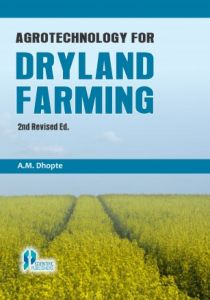
Contents: 1. Seed Treatment for seed vigour and viability in relation to rainfed farming/ O.P. Saxena and A.V. Pandya. 2. Watershed Concept and yield optimization under dryland farming/K.S. Bhaskar. 3. Differential properties of soils, nutrient availability and their management under semiarid regions/G.U. Malewar and Syed Ismail. 4. Micronutrient deficiency problems in Maharashtra and its corrective measures under dryland farming/B.N. Sagare and V.P. Babhukar. 5. Management of slowly permeable soils under dryland conditions/R.L. Kalane. 6. Organic measures for rehabilitation of degraded lands/V.N. Deshmukh, B.N. Akhare and M.B. Nagdeve. 7. Improvement of crop stand under dryland conditions/ N.G. Zode. 8. Agrometerological approaches for sustainable development in dryland agriculture/ S.S. Dhankar. 9. Climate as a tool to diagnose soil moisture stress and drought in rainfed condition/S.R. Ghadekar. 10. Water requirement and irrigation management of semi-arid and arid crops/R.P. Samui. 11. Dryfarming technology in relation to effective rain water management/S.B. Atale and G.M. Bharad. 12. Nutrient requirement of rainfed crops and its management with foliar sprays/P.S. Babhulkar and A.M. Dhopte. 13. Agrotechniqeus for sustained production in dryland areas/M.N. Sheelavantar and B.M. Chittapur. 14. Crop life saving measures in dryland agriculture/J.D. Patil. 15. Agro-Hydrological modelling for dryland water management/B. Bapuji Rao and M. Raghu Babu. 16. Targetted yield approach for fertilizer recommendations to rainfed crops/K.R. Sonar. 17. Precautions of avoid abiotic stresses/A.M. Dhopte. 18. Weed Management in dryland farming/A. Muthusankaranarayana. 19. Role of Antitranspirants in dryland/A.M. Dhopte. 20. Pre-signs of physiological maturity for early harvest/N.G. Zode. 21. Safflower : A Successful dryland crop/D.M. Hegde. 22. Soybean: A remunerative Crop for rainfed farming/O.P. Joshi, S.D. Billor, A. Ramesh and Ch. Bhardwaj. 23. Production technology for sesame/B.N. Reddy and A.R.G. Rangnatha. 24. Suitable medicinal and aromatic crops for dryland farming/V.S. Hudge, M.R. Shobhane, M.V. Dhoble and A.M. Dhopte. 25. Drought tolerant crop genotypes for rainfed farming/A.M. Dhopte. 26. Applications of Remote Sensing for Dryland Agriculture/Shyam. L. Deotale and Sapna S. Deotale. 27. Amelioration of Adverse effect of Drought With Plant Growth Regulators and Mineral Nutrients/R.D. Deotale.
It is known that dryland farming is not remunerative due to several constraints. Location specific technologies have been evolved for yield stabilization in dryland farming and conservation of fragile ecosystem by sustainable use of soil and water resources. Drought and flood situations are experienced some where in the country inspite of pletifull resources of waters unshine hours but poverty among farmers still exists. This is a point of sereous concern.
Agrotechniques are alone the answer for low productivity (0.8 t/ha) of 90% rainfed farming. To feed over one billion gallowping population of country, there is a need to increase the productivity to 1.5 t/ha by 2010 AD. This book deals with seed, soil, watersheds, crop, weed and nutrient management use of weather forecast, measure to save crops under abiotic stresses like drought and flooding, selection of crops and variety, reclamation of degraded land, organic recycling, agro-meterological approaches, water requirement, early harvest on physiological maturity, agro-hydro modelling and suitable medicinal and aromatic crops to make dry farming remunerative for welfare of common farmers. This is the first comprehensive book where large number of agro-techniques are incorporated. s are written by eminent scientists of national repute who have devoted their life time to solve probable problems of dryland. Agro-techniques can well be adopted with ease by farmers through extension agencies to avoid bankrupsy. Book includes all relevant aspects of rainfed farming and is therefore a valuable addition in Dryfarming and meets the expectations of all those interested in rainfed farming in the country and abroad. Long outstanding demand has thus fulfilled with this book. The novel approach of editor has made the readers task quick and minimized their efforts by compiling all agro-techniques together at one place for benefit of farmers.(jacket)